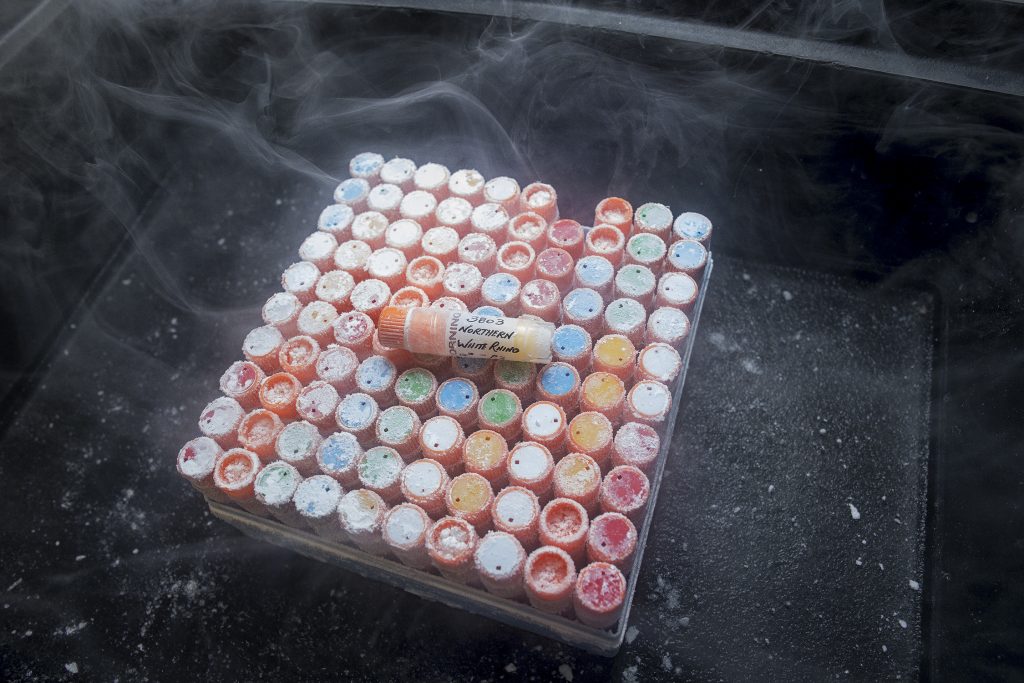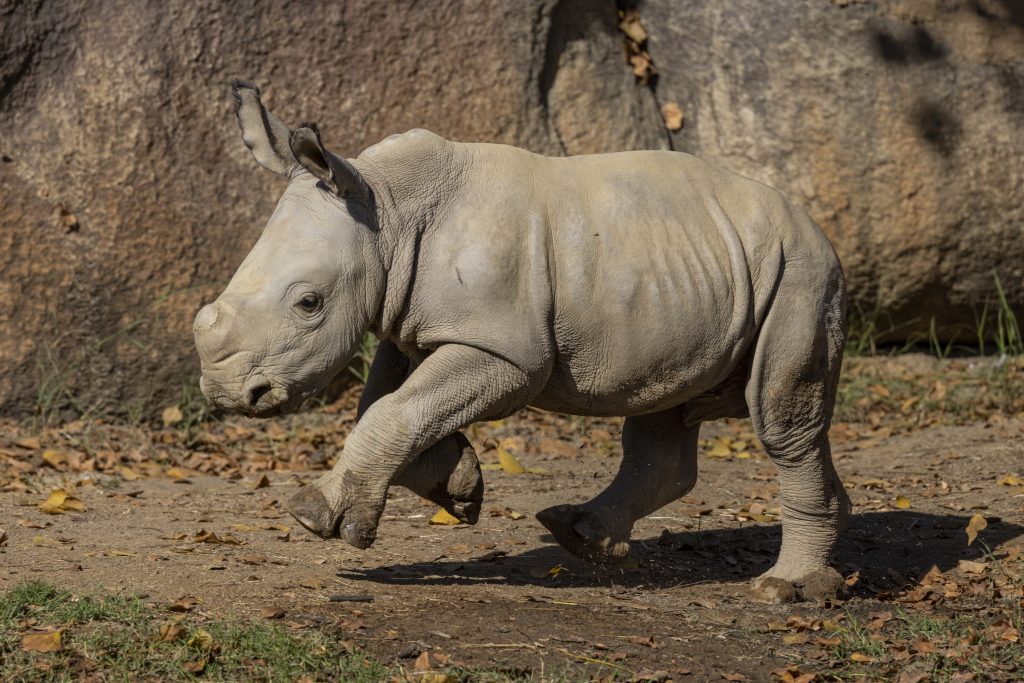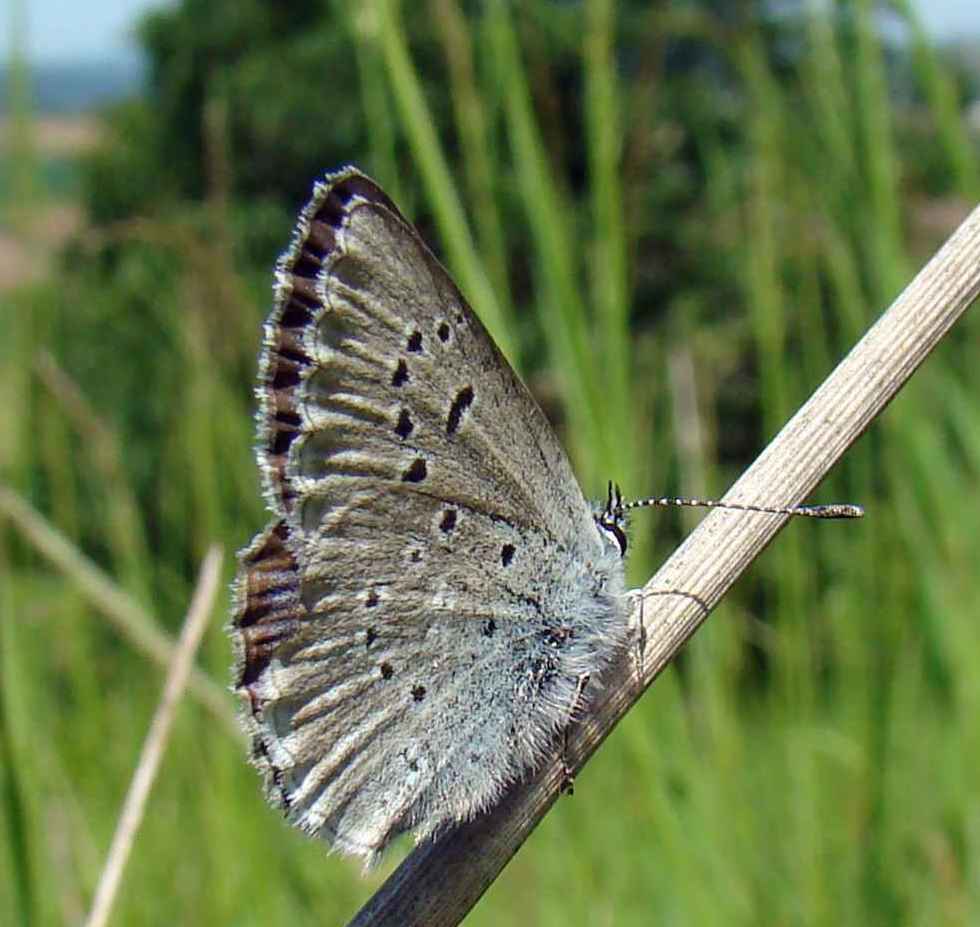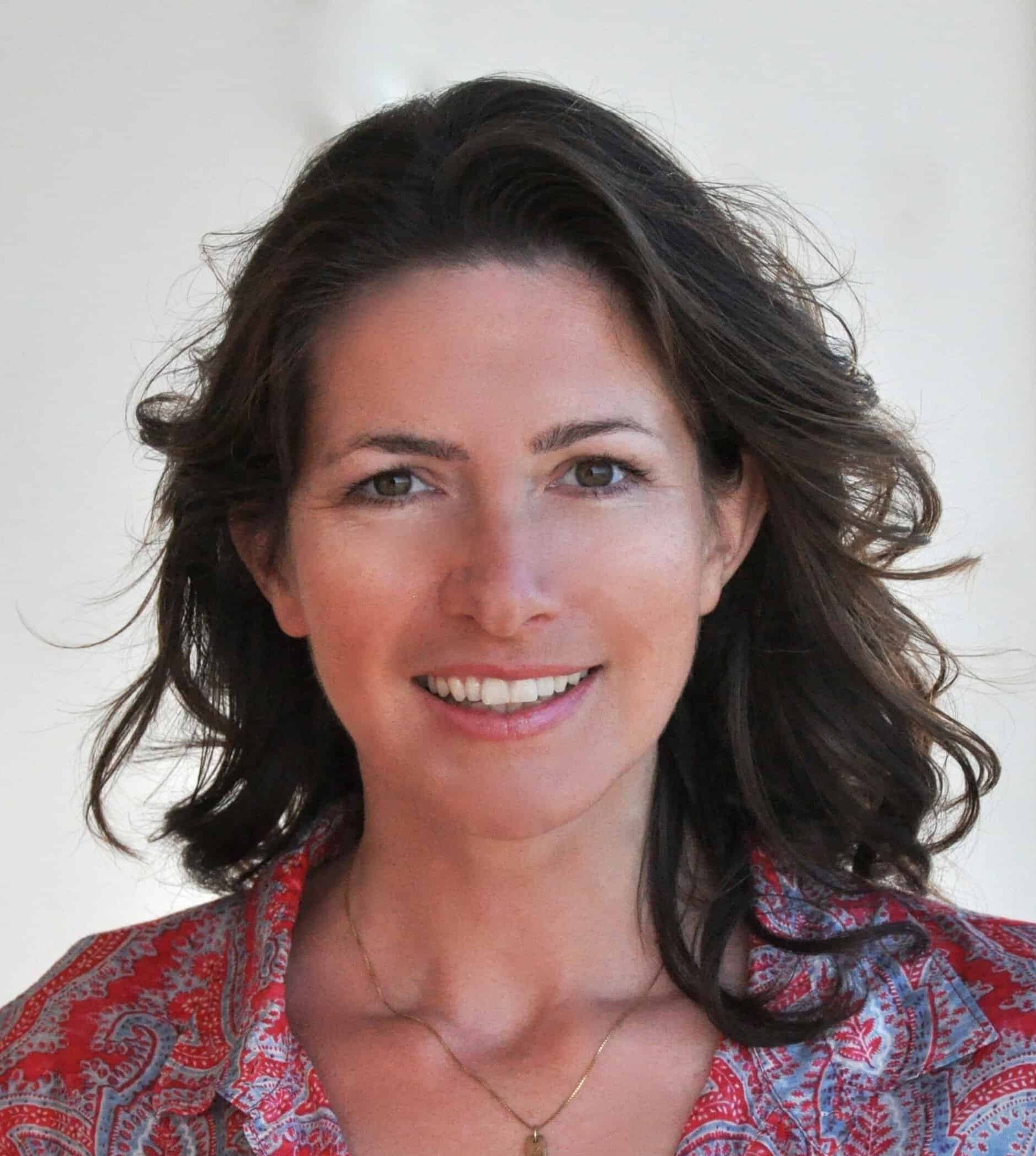This is the second story in our two-part series about scientists working to bring back extinct and threatened species amid our world’s decreasing biodiversity. Read the first story here.
“My biceps has become pretty muscular,” Barbara Durrant jokes before pushing an ultrasound wand into the rectum of a female rhinoceros named Wallis. Durrant’s arm disappears up to her shoulder. “My record in finding an ovary is 10 seconds,” she quips while leaning against the backside of Wallis who easily outweighs her by 2,000 pounds. Rhinoceros ultrasounds happen anally because the ovaries of the giants lie about two meters inside. Wallis munches contently on carrots and celery while Durrant examines her at the other end. Follicles the size of ping-pong balls appear on the computer screen.
Durrant is a gynecologist for giants because the southern white rhinos under her care have a specific role: They are the world’s best hope to save another subspecies, the northern white rhino, from complete extinction. For this purpose, the San Diego Zoo Wildlife Alliance carved out 3.5 acres of the 1,800-acre San Diego Zoo Safari Park and, with the help of generous donors, built the Nikita Kahn Rhino Rescue Center. A dozen rhinos trot on sandy ground just like in their original homeland the African savanna, enjoy 24/7 care by behavioral specialists and have state-of-the-art medical equipment like the garage-size, specially designed ultrasound pen where Wallis’s movement is restricted so Durrant can perform her exams. If everything goes well, the southern cows could become surrogate moms for northern white rhino embryos.

Until 2015, northern white rhinos lived at the San Diego park, too, but all efforts to motivate the remaining individuals to reproduce naturally failed worldwide. Now, only two northern white rhinos are left, Najin and Fatu in Kenya. They are both too sickly to bear any offspring and are being protected ’round the clock at the Ol Pejeta Conservancy by rangers armed with machine guns so they won’t suffer the same fate as others in their species that were killed for their horns. Two girls and no guy means the species is “functionally extinct.”
But there is hope. Only a mile north of the Safari Park lies the Alliance’s Frozen Zoo, the world’s largest collection of living animal cell lines. The Zoo’s cryogenic tanks hold samples from 12,500 endangered and extinct species. This unique frozen archive also includes cells from 12 northern white rhinos, including from the last bull, which died in 2018 in Kenya. Only because the Frozen Zoo has conserved several cell lines, Durrant emphasizes, did she and her colleagues build the Rhino Rescue Center and start the monumental effort to save the northern white rhinos. “There is enough material to safeguard their genetic diversity for the future,” Durrant explains. “Without the Frozen Zoo, this possibility would not exist.”
Crushed by negative news?
Sign up for the Reasons to be Cheerful newsletter.Durrant and the curator of the Frozen Zoo, Marlys Houck, are both members of the International Union for Conservation of Nature (IUCN). They research animals as tiny as bees, as mysterious as starfish and as giant as elephants. Both women work closely together because Durrant’s team is trying to convert animal cells that have been collected from the skin and organs of animals into pluripotent stem cells (cells that can grow into embryos). With several million dollars in funding, more progress in stem cell research and a lot of luck, scientists hope to one day gain new life from such stem cells. “We have already done it with mice and cats,” Durrant says. But will this work with 2,000-pound rhinos? Nobody knows for certain, but one thing is sure: The process definitely won’t happen as quickly as with mice, if only for the simple reason that rhinos carry their fetuses for 16 to 18 months.
Durrant wants to secure the survival of the northern white rhinos with the entire range of medical possibilities: artificial insemination, in vitro fertilization and cloning. Three years ago, she was the first scientist who successfully used artificial insemination with a southern white rhino in North America. She calls it “a crucial step toward bringing back the northern subspecies. We all cried when we saw the little embryo in the ultrasound. As a scientist, it is so rare that one can really make a difference.” The healthy calf, Edward, has since grown to a 1,000-pound teenager and grazes with the herd in the Safari Park.
For a healthy ecosystem
To save animals from extinction in a world that has seen, in the last 30 years, an average decline of animal populations of almost 70 percent, reproductive scientists are approaching unknown territory. The Frozen Zoo plays a crucial role in these efforts.
Thomas Hildebrandt, the director of reproductive sciences at the Leibniz Institute for Zoo and Wildlife Research in Berlin, was able to extract sperm from the last four male northern white rhinos, which is also preserved in the Frozen Zoo. Hildebrandt was the expert who determined, back in 2014, that none of the remaining northern white rhinos could reproduce naturally. He is also the first who successfully harvested eggs from female southern white rhinos. They, too, had been nearly extinct, their numbers reduced to about 20. But through intense international conservation efforts, they are now thriving, with 18,000 living in the wild again. (About 100 of them were born in the San Diego Zoo.)

Three years ago, Hildebrandt flew to Kenya to extract oocytes from the last two northern females, Fajin and Natu. This entails a life-threatening procedure, as the cows have to be put under anesthesia. “Their blood vessels are as thick as a toddler’s arms,” Hildebrandt says. “If I accidentally cut into one of these, they quickly bleed to death, and I have murdered the last females instead of saving the species.” He knew he would either go down in history as a hero who helped save the world’s rarest large mammal — or as the idiot who accelerated its demise.
The eggs were then flown to a specialized commercial lab in Europe that is usually known for its work with racehorses. There, the eggs were fertilized in vitro. Twenty-two embryos will remain frozen in Italy and Switzerland until science has progressed to the point where they can be safely implanted into a southern white rhino. Until now, no attempt to implant a fertilized egg into a southern white rhino has been successful. “You can imagine how precious each of these embryos is,” Durrant says about the European lab content. “You don’t experiment with something like this. They will only be implanted once we have successfully accomplished the procedure with numerous other embryos.”
Is this immense effort really warranted to save one rhino subspecies? “It is simply not acceptable to see them go extinct,” Hildebrandt shoots back. “After all, it is mankind that is responsible for their demise. Rhinos are not endangered because of evolutionary reasons or loss of habitat but primarily due to human greed. It’s the Kalashnikov that killed the rhinos,” Hildebrandt says. So many men believe that rhino horns work as an aphrodisiac that the giants have been slaughtered for them. Ten-year-old Wallis, too, arrived from South Africa with a bullet wound in her left side from a failed poaching attempt. The team in San Diego had to call in the bomb squad of the local fire brigade to locate the bullet casing with their x-ray because the zoo’s x-ray machines weren’t big enough. In truth, the horns are simply made of keratin, roughly the same substance as our fingernails. It increases virility exactly as efficiently as chewing your nails. And yet, the planet loses about three rhinos a day to poaching.
“These animals have an important role in the ecosystem,” Durrant explains, “and because we as scientists may have the solution to prevent their extinction, we have the responsibility to try.” As a vegetarian, she shudders as she discusses that she sometimes has to use pig oocytes in stem cells experiments. “These animals are so sensitive and so smart,” she says emphatically. But the knowledge gained in saving the northern white rhino, Durrant argues, will also benefit other rhinos, almost all of which are threatened as well. For instance, Hildebrandt recently returned from Borneo where he does similar fertility work with the Sumatra rhino, which is down to about two dozen individuals. “What we learn here will benefit other species, too,” Durrant emphasizes. And without recent advances in reproductive technology, the prospect of the rhinos’ survival would certainly be grim.
Whether one approves of these methods or not, the rhinos’ future will be decided in a lab. “The scientific methods sound futuristic,” Durrant admits, “but they work.” She is confident that northern white rhinos will once again inhabit the African savanna. “In 10 to 20 years we will see a healthy population of the white rhino.”
The decision of who will be chosen as surrogates has yet to be made, but Durrant is already preparing her cows. Part of this process is to get them used to weekly ultrasounds, learn more details about their fertility cycles and let them experience pregnancies. Just like with humans, the first birth is often the most difficult. Livia, a 12-year-old southern white rhino, has just given birth to her first calf. Neville is only a few weeks old, about as tall as a Great Dane and already weighs 120 pounds.
“Careful! Stay close to the barn wall! The horns can reach through the metal barrier,” her caretaker warns as we approach mother and son. But little Neville is curious about the visitors and trots to the railing, under the watchful eye of his mom. He pushes his head through the metal barrier, his horn just a small nub. His skin feels soft like suede, and as we pet him behind the ears, he grunts with pleasure.
“It’s important that the animals are happy here,” Durrant says and pets him too. It’s her first time touching him, and though she has worked here for decades, she beams proudly.
If everything goes well, Livia or Wallis could give birth to the first northern white rhino here in eight or 10 years. To save the survival of an entire species.










